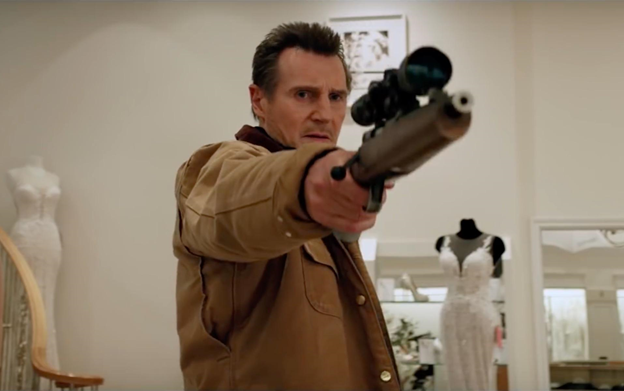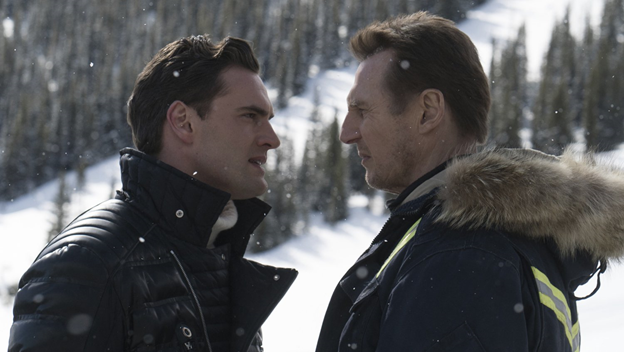Liam Neeson has made a name for himself headlining bargain-bin thrillers, always offering a subdued Irish brogue and calculated suave that helps bridge the gap between unsightly mediocrity and watchable entertainment. His latest, COLD PURSUIT, based on the Norwegian film IN ORDER OF DISAPPEARANCE, enters the arena at a strange time, immediately following Neeson’s controversial remarks regarding his wish to once avenge the rape of a friend by murdering a black man. The film, subsequently, flopped, garnering a measly $11 million at the box office. It’s a shame, since the film is actually pretty engaging and quite a departure from his usual fare—65-years-old and the man still springs into every set piece with substantial energy and good ol’-fashioned leading man gravitas.
COLD PURSUIT opens with an Oscar Wilde quote, which should hopefully orient viewers toward a more comedic direction than they’re used to. Neeson stars as Nels Coxman (an already comical switcharoo from the original’s Nils Dickman), a snowplow driver who, following his son’s murder, finds himself entangled in a turf war between a cocaine kingpin and a gang of indigenous men. The film has a bit of a rocky start, with Neeson’s relationship with Laura Dern (!) particularly vague, and there’s about a single scene with Neeson and his son before his untimely death (the murder scene of which is the worst in the film, with director Petter Moland seemingly having a hard time recalling basic rules of suspense). Things pick up soon after, however, and it’s hard to not derive pleasure from Liam Neeson wielding a sawed-off sniper rifle and blowing away baddies with shocking ease (there’s no mention of a military background or anything similar, so I just assume that a father’s love imbues one with superhuman combat reflexes).

“Liam, put the gun down. This isn’t Northern Ireland.”
Perhaps most notable in COLD PURSUIT is its undercurrent of gallows humor. There’s a bold scene in which Neeson and Dern inspect their son’s body as the mortician struggles to level out the gurney. It’s not a scene one would expect from a mainstream American film—mining comedy from the death of a child—and Petter Moland manages to stick with the gag for an admirable amount of time, successfully securing the laugh where most directors would abandon the gag before it ripened. The prolific drug lord, played with by tenacity by Tom Bateman, is an equally bizarre creation—Bateman manages to be both puerile and menacing simultaneously. It’s a tricky balancing act, as most actors who attempt this sort of role lean too heavily into the goofy side, robbing themselves of their ability to be taken seriously. Dern is seriously underutilized, and her character’s absence from most of the proceedings strikes one as a major misstep. (I mean, you have one of the greatest living actresses and you barely use her?!)
Unusual is the film’s decision to neglect Neeson for long stretches of the runtime in favor of spending time with Tom Bateman and the indigenous group, including, in an odd decision, glimpsing at Bateman’s relationship with his ex-wife. While it’s an interesting decision, I’m not sure the filmmakers realize they have an absolute firecracker in Neeson, who manages to turn every moment of violence and solemn introspection into one of quiet yet explosive self-loathing. The film essentially forgets why he’s entered into the turf war—we’re never reminded that the reason for his savagery is his son’s death (unhelpful that we barely know the son to begin with).

“Man, you’ve got great skin! What’s your routine?”
“Three applications of moose blood and a thin layer of unfertilized goat milk.”
Of note is the Colorado locale—fractious pine trees and discussions of the state’s marijuana policies abound, and the snow-capped skyline offers a suitably oppressive backdrop to the brutal violence. There’s some intriguing commentary here about the commodification of indigenous bodies, and fractured masculinity, though ultimately the film’s aspirations aren’t too high, content to be just a reliable thriller, even if violence disappears from the film for substantial periods (not necessarily a problem with this reviewer, though may initiate whiplash for audiences used to Neeson’s more kinetic outings). The picture suffers from some myopic narrative choices—one female character is used simply as a punching bag, with the audience expected to find the existence of a woman with an accent to be absolutely hilarious, and a reveal of two characters’ homosexuality is poorly handled, with emphasis added where simple observation would have satisfied. Still, Petter Moland is clearly having fun here, and it’s nice to see Neeson in a film that isn’t entirely predicated upon misery and gloom. It’s a worthwhile film, if overlong—maybe Neeson should have saved his shocking anecdote until after the film premiered?
















Comments